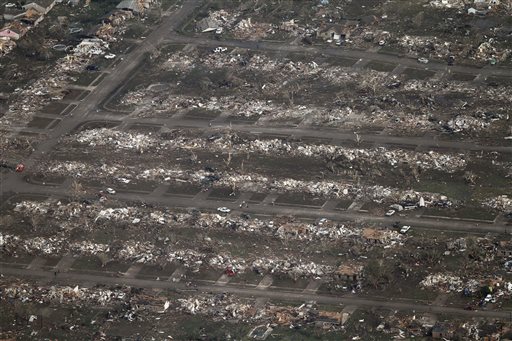In Oklahoma, particularly in the springtime, dangerous weather is a part of life. And so are the local TV news stations in my home state.
Chances are good that the bottom corner of your TV screen come May has the familiar map of the state covered with red, yellow, and green Doppler radar images on loop denoting the severity of the latest thunderstorm, flash flood, or tornado warning in your area.
Weather is routinely a matter of life and death in the state, and meteorologists rank somewhere between football coaches and pastors on the authority spectrum. If there’s anyone left in journalism with the fabled stature of a Walter Cronkite, it’s probably an Oklahoma weatherman, and probably Gary England, whom OKC blog The Lost Ogle calls “our Severe Weather Savior” (only half in jest).
Yesterday’s tornado was the second catastrophic twister to hit the Oklahoma City suburb of Moore in 14 years and as with the May 3, 1999, tornado, viewers got lots of advance warning from their local TV stations. As I write this, the death toll is at 91 and climbing (UPDATE: The medical examiner has dialed that back sharply to 24 so far this morning), but there’s no doubt that the OKC TV weather folks saved untold lives.
On KFOR, for one, meteorologist Mike Morgan told viewers ahead of time that the storm would be enormous and that if they couldn’t get underground to flee the area—astonishing advice to those of who grew up climbing in the bathtub with couch cushions or eying bridge underpasses in case we had to book it out of our cars (the whole lie-in-the-ditch advice never seemed sound to me).
He was right. Here’s hoping the people in this neighborhood heard him:

As important as the meteorologists are in warning people, the helicopter pilots/reporters chasing the storms are critical too. They beam back pictures to everyone in the metro that show how deadly serious a storm is. Back in 1999, I watched that series of tornadoes on local TV for two hours before it passed west of where I was in Norman. If I hadn’t been watching it live on TV, I probably would have gone ahead and tried to make a hockey game in downtown OKC, driving right into the path of a funnel with wind speeds measured at 318 mph.
In other words, this kind of journalism directly saves lives. It’s a real public service. And once the threat has passed on, these choppers become first-line reporters on what has happened.
Brian Stelter, who did great work from Joplin for The New York Times, quotes KFOR’s chopper pilot right after the storm had passed:
Once the tornado passed, the helicopter pilot, Jon Welsh, turned back to survey what had been lost. He pointed out a landmark for local viewers, Veterans Memorial Park, and said starkly, “It’s gone.” Nearby was a housing development. “Completely gone.” Mr. Welsh’s cameraman panned to the south, toward more homes. “Gone.”
Two minutes later he could see a school in the distance. “Oh, my God,” he said, grasping for words. Mr. Welsh called out for police while he tried to identify the cross streets for what turned out to be Plaza Towers Elementary School, one of at least two schools decimated by the storm. The cameraman’s close-up showed adults running toward the rubble.
It wasn’t just the meteorologists and helicopter teams doing outstanding work in Oklahoma City yesterday. I watched KFOR and News9, and the anchors’ tone was right, the reporting was excellent, the reporters were professional but human (I’m thinking of reporter Lance West breaking up on camera from the site of the Plaza Towers Elementary tragedy), and they were cautious but on top of breaking news. I saw no real missteps.
Jim Roberts, executive editor of Reuters Digital, noticed this too, writing on Twitter:
Worth repeating. Very impressed by thoughtful, professional, experienced local news reporters & anchors in Oklahoma today.
That is very, very difficult to pull off in a fast-moving, confusing story like this.
Ryan Chittum is a former Wall Street Journal reporter, and deputy editor of The Audit, CJR’s business section. If you see notable business journalism, give him a heads-up at rc2538@columbia.edu. Follow him on Twitter at @ryanchittum.
